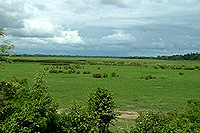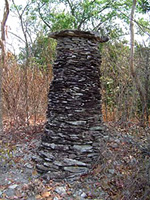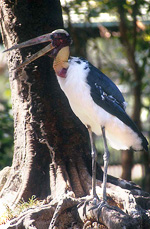Kiet Ngong Village lies within the enchanting natural scenery of the 2,400 km2 Xe Pian National Protected Area (Xe Pian NPA). This mainly Lao Loum (lowland Lao) community of approximately 150 households is located at the edge of the Kiet Ngong wetlands, one of the largest and least altered in the region, and at the foot of Phou Asa, a large rock outcrop renown for its intriguing ruins and superb views of the dense semi-evergreen forests below. Isolated from the bustle of the main roads but within an hour’s drive from Pakse, Kiet Ngong’s traditional houses, temple and working elephants offer an accessible window into authentic Lao rural life.
 |
Xe Pian NPA was established to conserve biodiversity and is considered to be one of the most important areas in Indochina, particularly for its many species of large mammals and waterbirds. Its waterbirds include the vanishingly rare Giant Ibis and White-winged Wood-Duck, and other globally threatened species, like White-shouldered Ibis, Sarus Crane, and Lesser Adjutant, which may still visit Kiet Ngong marsh. Although Rhinoceros, Kouprey, Eld’s Deer, and Hog Deer have already disappeared from the area, Asian Elephant, Tiger, Gaur, Banteng, Leopard, Sun Bear, Black Bear and Dhole (Wild Dog) are still found in the NPA. These reclusive species are very difficult to see, but their sign can be observed in the interior, along with impressive and more visible species, such as Yellow-cheeked Gibbons and hornbills. Biological surveys in Xe Pian have produced a long list of species, including 62 mammals, 334 birds, 44 reptiles, 21 amphibians and 176 fish, but many groups are still little known.
Almost 10,000 people live within Xe Pian and close to 50,000 within 5 km of its boundary, many practicing traditional agriculture and collecting forest plants to support their diet. They benefit from the biodiversity of the area and are called upon to maintain it for future generations.
Elephant rides to the top of Phou Asa and back are well-established and a popular option. Book your ride the day before through the Visitor Information Centre in Pakse or Champassak District or with an official tour company. Elephant-back trips can also be arranged to other places; ask the Visitor Information Centre or your tour company to inquire for you.
 |
Phou Asa is reached by a short walk or elephant ride from the village along a forest trail. The summit opens out to provide a stunning view over large areas of southern Lao. The forests of Xe Pian and Dong Hua Sao NPAs appear to stretch out endlessly from the Kiet Ngong wetland. To the north is the Bolaven Plateau, and on a clear day waterfalls can be seen cascading from it. Ahead to the east is the Xe Khong floodplain in Attapeu, and lining the horizon is the Annamite Mountains on the Vietnamese border. At the top of the outcrop is a ring of stone pillars. Legends abound about these remains, but it is unknown if the structure was built for religious or military reasons.
 |
Village guides are available to take visitors on half- or full-day walks to Phou Asa and its surroundings, interpreting its many medicinal plants and non-timber forest products. The 7 km long eco-trail begins at the foot of Phou Asa and offers 3-4 hours of steady walking through tall semi-evergreen forest. Some trees along the trail are labeled, and there are good places to rest or observe birds. An important natural resource, which can be seen on the walk, is the Mak Chong (Malva Nut) tree. It only grows in original forest and reaches its greatest abundance in southern Lao. In some years, the Mak Chong harvest from Xe Pian alone may be sold for more than US$ 1,000,000 in China. Local harvesters only receive a tiny fraction of that revenue, but it is a significant source of income nonetheless.
 |
During the dry season (November-April) there is a trail around the wetland to Donlay Island, which takes about two hours if walked slowly. Many waterbirds can be seen, so bring binoculars if you have them. On the way you will pass the Giant Rock (Hin Huoa Yak in Lao), a sacred place with a superb view. The trail continues to Phapho Village, but you will probably want to return the way you came.
| All treks and walks should be done with a village guide. |
Donlay Island can also be reached by canoe. Your boatman will take you slowly around the edge of the wetland, where a passage through the thick mats of floating vegetation is kept open by boats and water buffaloes. A canoe trip offers a closer look at the birds and local fishing techniques than a walk around the wetland.
Accommodation is in keeping with the simplicity of Lao village life. The choice is between sleeping huts or a home-stay. There are five small, local-style huts about 250 m south of the last house in the village (1 km from the village temple). A single hut sleeps two sharing. This is the place to stay if you want to wake up to a view of the wetland. Alternatively, a home-stay offers the opportunity to interact with a local family. Also available is a privately owned ecolodge located just outside the village.
Like the accommodation, food is simple and local. Sticky rice is available with a choice of locally caught fish or chicken. It can take some time to prepare, so try to order an hour in advance and be patient. Bottled water, soft drinks and beer are available, but rarely cold. Handicrafts and souvenirs made by Kiet Ngong villagers are sold in the village exhibition hut near the entrance to the village.
Villagers request that you book ahead to arrange for elephants, guides and accommodation (call
030 5346547
Lao speakers only). For booking or for more information, visit the Visitor Information Centre in Pakse (031-212 021) or the Visitor Information Centre in Champassak District. You may also book in advance with a major tour company or at the privately owned Kingfisher Ecolodge.
The easiest way is to book a taxi through a travel agent or hotel in Pakse. Several local buses (song thaew) run daily between Pakse’s southern bus station (8 km east of town) and Kiet Ngong. You can also catch one of the many buses, which travel down Route 13 to Khong District, and get off at the junction with Route 18 at Km 48 (si-sip-paet), in Thangbeng Village. The Xe Pian NPA Headquarters are here, and you can ask for information and help on how to get to Kiet Ngong by bus, car, tuk-tuk or perhaps on the back of a motorbike. You must follow Route 18 for 7 km eastwards, then turn right at the large signboards for the last 1½ km along a dirt road to Kiet Ngong.

